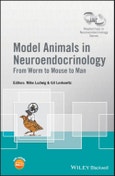Model Animals in Neuroendocrinology: From Worm to Mouse to Man offers a masterclass on the opportunities that different model animals offer to the basic understanding of neuroendocrine functions and mechanisms of action and the implications of this understanding. The authors review recent advances in the field emanating from studies involving a variety of animal models, molecular genetics, imaging technologies, and behavior assays. These studies helped unravel mechanisms underlying the development and function of neuroendocrine systems. The book highlights how studies in a variety of model animals, including, invertebrates, fish, birds, rodents and mammals has contributed to our understanding of neuroendocrinology.
Model Animals in Neuroendocrinology provides students, scientists and practitioners with a contemporary account of what can be learnt about the functions of neuroendocrine systems from studies across animal taxonomy.
This is the seventh volume in the Masterclass in Neuroendocrinology Series, a co-publication between Wiley and the INF (International Neuroendocrine Federation) that aims to illustrate highest standards and encourage the use of the latest technologies in basic and clinical research and hopes to provide inspiration for further exploration into the exciting field of neuroendocrinology.
Table of Contents
List of Contributors, vii
Series Preface, xiii
Preface, xv
Acknowledgments, xix
About the Companion Website, xxi
1 Neuroendocrine Regulation in the Genetic Model C. elegans, 1
Charline Borghgraef, Pieter Van de Walle, Sven Van Bael, Liliane Schoofs,Wouter De Haes, and Isabel Beets
2 Neuroendocrine Control of Reproduction in Aplysia by the Bag Cell Neurons, 29
Raymond M. Sturgeon, Alamjeet K. Chauhan, and Neil S. Magoski
3 Neurohormonal Regulation of Metamorphosis in Decapod Crustaceans, 59
Scott F. Cummins and Tomer Ventura
4 Drosophila as a Model for Neuroendocrine Control of Renal Homeostasis, 81
Julian A.T. Dow, Kenneth A. Halberg, Selim Terhzaz, and Shireen A. Davies
5 Development and Function of the Zebrafish Neuroendocrine System, 101
Jakob Biran, Janna Blechman, Einav Wircer, and Gil Levkowitz
6 The Organization and Activation of Sexual Behavior in Quail, 133
Charlotte A. Cornil
7 Hamsters as Model Species for Neuroendocrine Studies, 161
Jo E. Lewis and Francis J. P. Ebling
8 The Socially Monogamous Prairie Vole: a Rodent Model for Behavioral Neuroendocrine Research, 181
Meghan Donovan, Yan Liu, and Zuoxin Wang
9 Brain Dead: The Dynamic Neuroendocrinological Adaptations during Hypometabolism in Mammalian Hibernators, 207
Samantha M. Logan, Alex J. Watts, and Kenneth B. Storey
10 Genetically Altered Mice as an Approach for the Investigation of Obesity and Metabolic Disease, 233
Rebecca Dumbell and Roger D. Cox
11 HAB/LAB Mice and Rats: Approaching the Genetics and Epigenetics of Trait Anxiety, 257
Ludwig Czibere, Rebekka P. Diepold, Alexey E. Umriukhin, Rainer Landgraf, and Sergey V. Sotnikov
12 The Brattleboro Rat: The First and Still Up-to-Date Mutant Rodent Model for Neuroendocrine Research, 279
Dora Zelena and Mario Engelmann
13 The Marmoset as a Model for Primate Parental Behavior, 297
Atsuko Saito
14 Domestication: Neuroendocrine Mechanisms of Canidae-human Bonds, 313
Yury E. Herbeck, Rimma G. Gulevich, Marina Eliava, Darya V. Shepeleva,Lyudmila N. Trut, and Valery Grinevich
15 Sheep as a Model for Control of Appetite and Energy Expenditure, 335
Belinda A. Henry and Iain J. Clarke
16 The Horse: An Unexpected Animal Model for (Unexpected) Neuroendocrinology, 361
Anne Duittoz, Juliette Cognié, Caroline Decourt, Flavie Derouin, Auréline Forestier, François Lecompte, Abderrahim Bouakkaz, and Fabrice Reigner
17 Humans - The Ultimate Model for the Study of Neuroendocrine Systems, 383
Lisa Yang, Chioma Izzi-Engbeaya, and Waljit S. Dhillo
Glossary, 407
Index, 421








